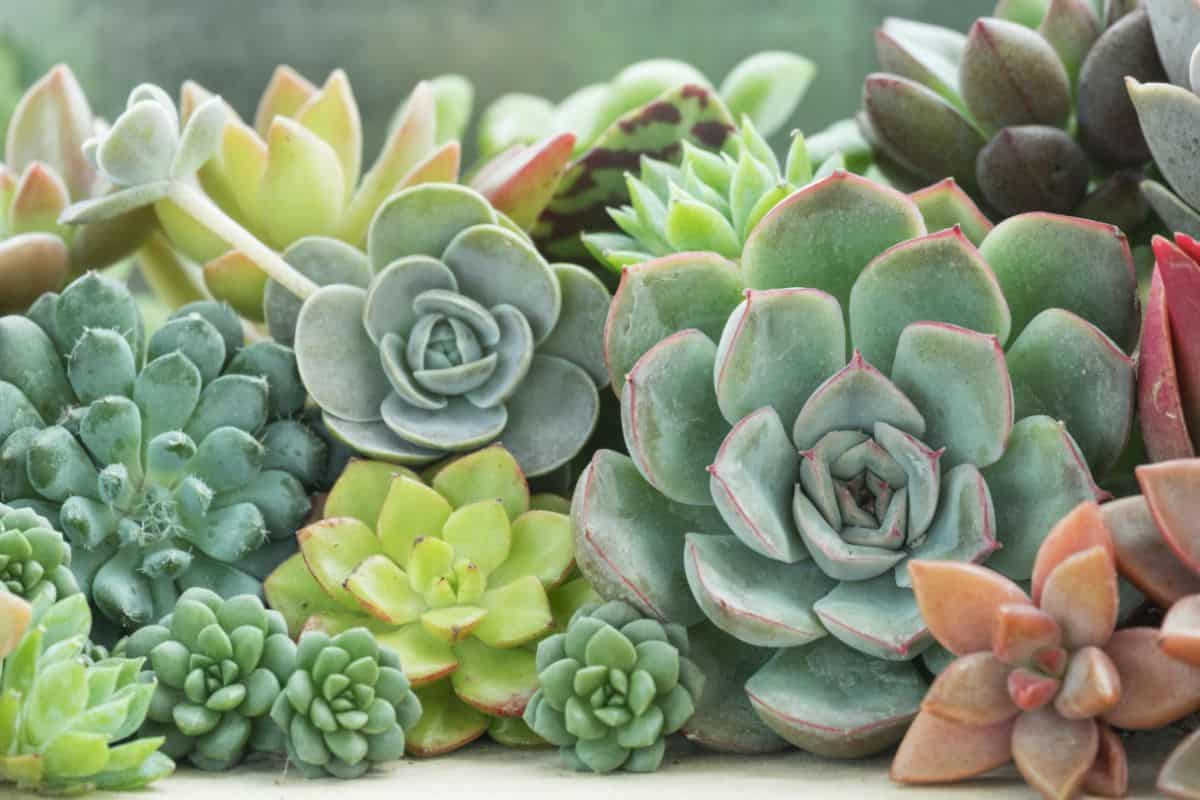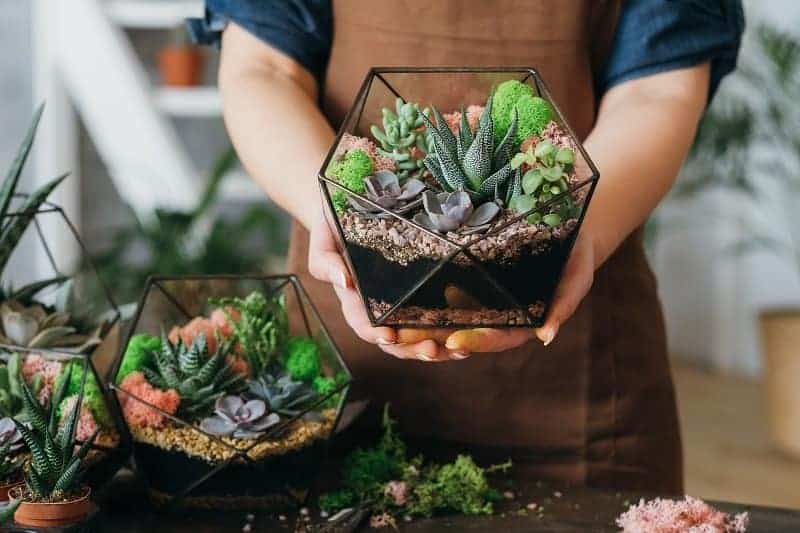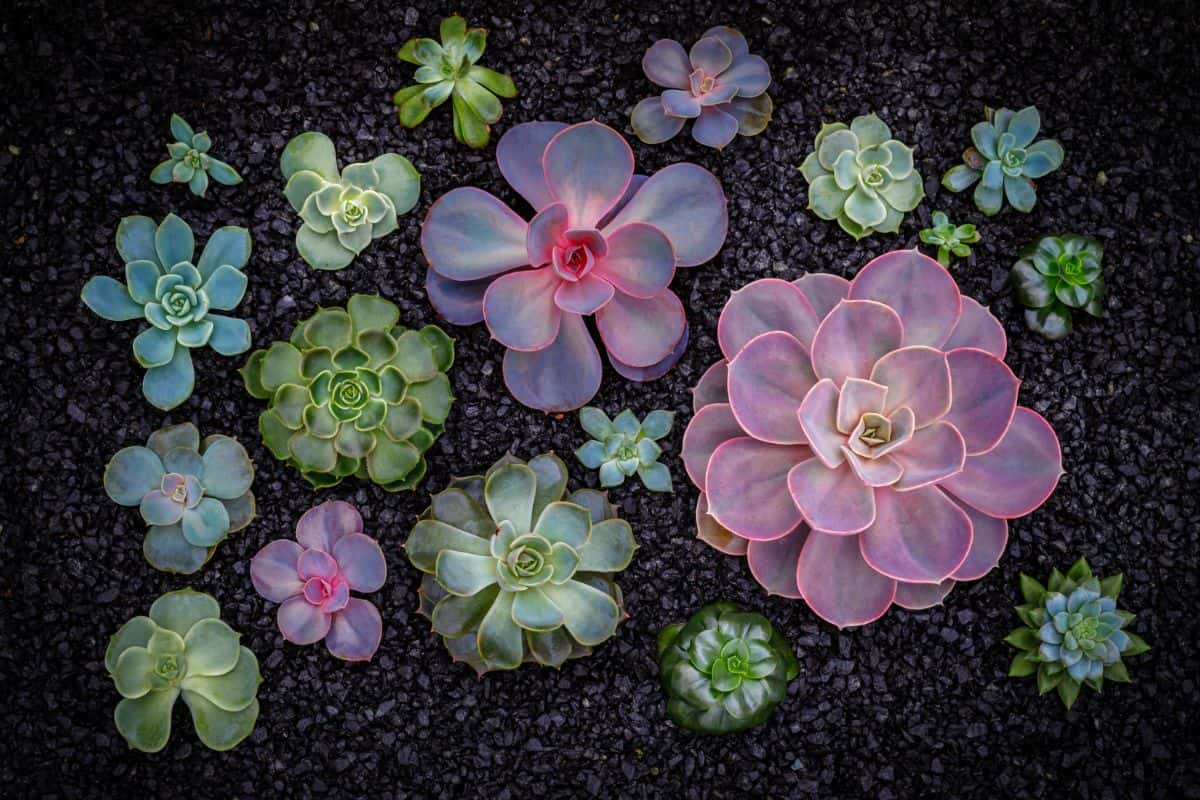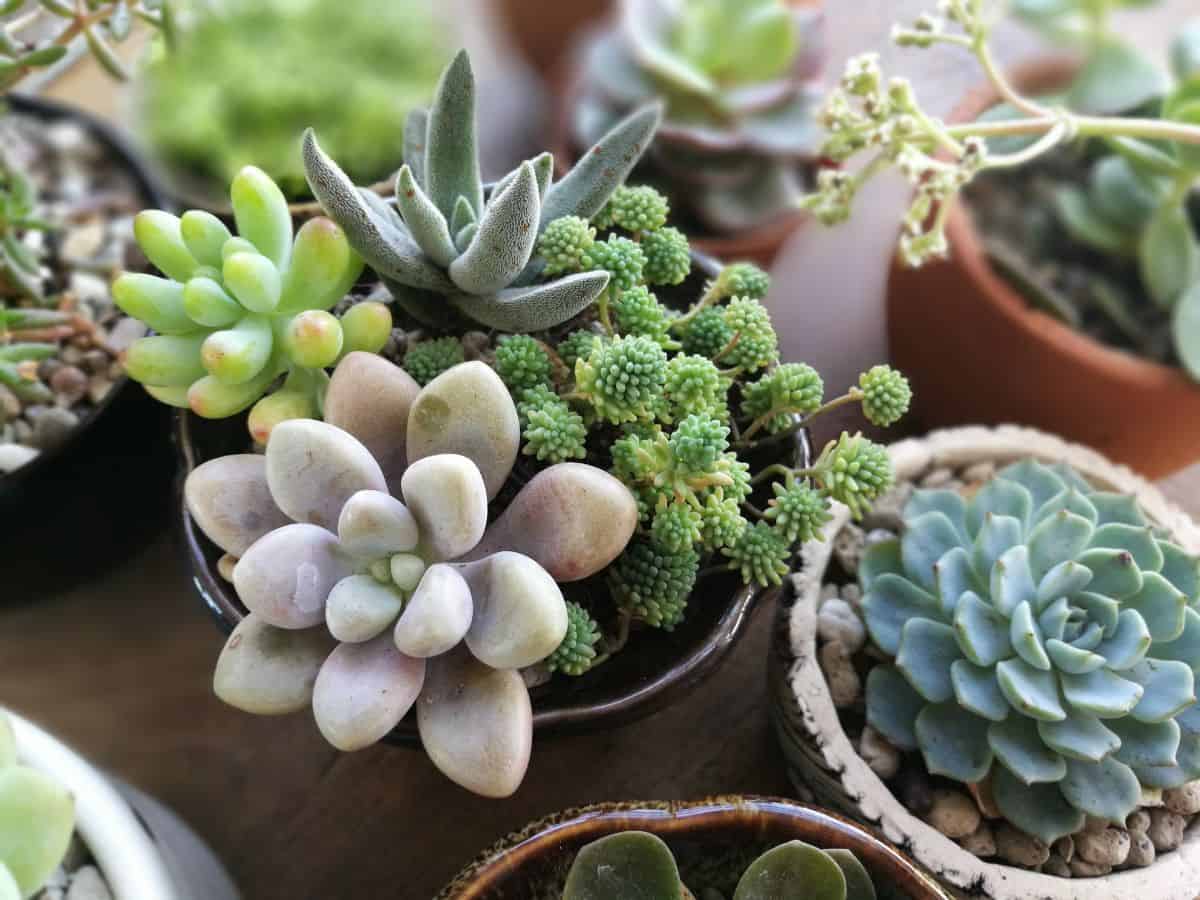Whether you grow succulents indoors or outside, it’s important to know how big your plants will get so you can plan your garden or décor accordingly. It can be disappointing to end up with a plant that’s not the size you expected it to reach, especially if you’re limited on space.

So, just how big do succulents get? Well, since hundreds of different species of plants can be categorized as succulents, there isn’t a clear-cut answer. How big a succulent gets will depend on the species as well as the conditions it’s grown in. However, with a little information you should be able to accurately estimate how big your succulent will be at maturity.
Jump to:
The Average Size of Succulents
Succulents vary widely in terms of size, so unless you know the specific species of plants you have in your home, it’s difficult to estimate how big they’ll get. When it comes to succulents, knowledge is king, so the more you know about succulents, the better you’ll be able to predict their mature size.
Some species of succulents can be quite small. This is especially true for succulents living in particularly harsh climates where they don’t have the resources to grow to substantial sizes.

One of the smallest succulents in the world is Blossfeldia liliputana, a tiny cactus which measures about half an inch in diameter at maturity. Lithops is another petite succulent, that typically stays under 1.5 inches in diameter.
Both Blossfeldia liliputana and Lithops tend to grow in clumps, so rather than a single large plant, you’ll find a group of tiny succulents growing together.
On the other end of the spectrum, there are succulents that can reach incredible sizes. Adansonia digitata, also known as the Baobab tree, is frequently regarded as the largest succulent in the world. Native to Africa, it can reach up to nearly 100 feet in height and 36 feet in diameter.
In North America, the Saguaro cactus (Carnegiea gigantea) holds the title of largest succulent. These gigantic cacti can grow upwards of 45 feet tall and when fully hydrated can weigh nearly 5,000 pounds.
These are extreme examples of the diversity of succulents and most species encountered by the average garden will be more manageable sizes, but it’s important to understand the wide range of plants covered by the term ‘succulent.’
Even if you do know the exact species of succulents you have in your collection, their mature sizes can vary according to the care they’re given. Succulents that are grown under ideal conditions will reach larger sizes than those grown in less favorable conditions.
Additionally, it is possible to control how large your succulents get, but we’ll discuss that more in detail in a minute.
Factors That Affect Size

As previously mentioned, succulents grown in ideal conditions will reach a larger size at maturity than those living in barely survivable conditions. Succulents are hardy plants that can survive a range of harsh conditions, but there is a difference between surviving and thriving.
It’s important to keep in mind that ideal conditions are different for various species of succulents and cacti, but in general there are four factors that affect a succulent’s growth.
Read Also: Wholesale Succulents for DIY Projects
Sunlight
In general, succulents tend to prefer sunnier conditions, but there are species that prefer different amounts of sunlight. Rhipsalis, for example, are epiphytic cacti that tend to live in the nooks and crannies of trees rather than in the soil. For this reason, they prefer filtered sunlight to simulate the amount of sun they receive through the trees’ canopies.
No products found.
Many types of cacti, such as Opuntia and Cereus, may prefer full sun. These are typically species that live in the desert with little shade from other plants, so they have adapted to life in direct sunlight.
It’s important to know your succulents’ preferred level of light, as it can not only affect their growth, but their survival. Plants that prefer filtered sunlight will become sunburned in direct sunlight, while those than prefer full sun may become etiolated with fewer hours of sunlight.
Sunburn can be deadly if left untreated, so it’s crucial that you continuously monitor new plants to make sure they’re handling the light in their new location well. Etiolation will not affect your plants’ health, but it tends to be unsightly and is not reversible.
It’s safe to say that if you’re growing your succulents in light conditions that are not ideal for that species, your plants’ growth is going to be affected. Additionally, succulents that aren’t getting enough light tend to have paler colors and are unlikely to bloom.
Temperature
As with sunlight, temperature can have a serious effect on your succulents’ growth. Most species of succulent are not frost tolerant, so freezing temperatures should be avoided. Sempervivum and Sedum can withstand frigid weather, but they are an exception rather than a rule.
Although many species of succulents and cacti live in environments where temperatures can be uncomfortably hot, there are a few that may not do well in particularly warm weather. When combined with too much sun, heat can spell trouble for many types of succulents.
In general, most succulents will do well in temperatures between 50 and 90 degrees. Some species may require specific temperatures for rapid growth or flowering, while others can be sensitive to sudden temperature changes such as drafts.
In order to encourage even and correct growth, you should always protect your succulents from extreme temperatures and temperature changes.
Soil

Since succulents gain the majority of their nutrients from the soil they’re planted in, it should be obvious that soil will have a major impact on a succulent’s growth rate. Again, the exact type of soil required for optimum growth will vary according to species, but for most succulents it’s safe to say that well-draining soil with little clay and organic material is ideal.
A succulent’s soil should never contain high amounts of water retaining elements such as clay and peat moss. Water retention in the soil will only lead to root rot and the eventual death of the plant.
For optimum health, the soil should only contain ingredients that promote proper drainage such as sand, gravel, and perlite. Though it may not seem like it, these elements do typically contain the proper minerals needed by the plant for growth.
However, after being planted in the same soil, especially in a container, the plant may deplete the soil of nutrients which can lead to nutrient deficiency. If your succulents have been in the same container for a long time without repotting them or adding nutrients, you may begin to notice yellowing of the top leaves.
Yellowing of the top leaves is a common sign of nutrient deficiency, while yellowing of the bottom leaves is often a sign of overwatering, so it’s important to know the difference. If your plant is showing signs of nutrient deficiency, you might consider repotting or giving it additional nutrients.
Without the proper nutrients, a succulent is unlikely to reach its maximum size at maturity. Adding nutrients can be helpful in many cases, but repotting is also important as your succulents won’t be able to grow if they don’t have room to expand.
Though succulents do not typically grow deep roots, they can become rootbound if left in the same container for a long period of time. Not only does repotting give your plant room for its roots to expand, but the new soil will also provide it with the nutrients necessary for additional growth.
Moisture
Improper watering is probably the most common cause of succulent death and growth problems. Overwatering is one of the most frequent problems encountered by new succulent caretakers but underwatering can also occur.
Overwatering succulents often leads to root rot and the death of the plant, but it doesn’t usually affect a plant’s growth because it won’t live long enough to grow much.
Though succulents are drought-tolerant plants, it is actually possible to underwater them. Succulents are capable of going long periods without water, but that doesn’t mean it’s ideal.
Without adequate water, succulents will grow more slowly and may not ever reach the same size as plants who receive a more appropriate amount of moisture.
That being said, periods of minimal or no water are completely normal for succulents and they have adapted by going dormant. During dormancy, the plant almost stops growing, so it needs little water to survive.
Many species of succulents go through periods of dormancy, usually in winter, that can last several months. These periods are sometimes crucial to the plant’s reproductive cycle, but many can survive without going dormant.
Dormancy is more complicated than just a reduced exposure to moisture, but the basic premise is that it is a period of slowed growth, so be sure to do your research to see if any of the succulents in your garden experience dormancy.
It’s also important to note that humidity will also affect a succulent’s growth rate. In humid environments, a succulent will be able to survive much longer without actual water, as they can absorb some moisture form the air.
The soil will also take longer to dry, so as long as the plant doesn’t develop root rot, it can go longer periods of time between watering. Similarly, succulents grown in climates with low humidity may need water more frequently to achieve optimum growth.
How Fast Do Succulents Grow?

When compared to other types of plants, succulents are not fast growers. However, as with every other aspect of succulents, there is a wide range of growth rates among succulents and cacti.
Going back to the topic of dormancy, it should be noted that succulents do most of their growing during the time that they are not dormant. The growing season usually takes place during spring and summer with dormancy occurring once the temperature drops and days get shorter.
If succulents are grown under ideal conditions, which means they get the right amount of water and sunlight, they will be able to grow as much as possible during their growing season.
Whether you’ll be able to see noticeable growth after a single growing season will depend on the species. Some succulents may grow considerably in just a few weeks, while others may appear to stay the same size for years.
It’s even possible for different cultivars of the same species to grow at different rates. So even if you grew two different cultivars under the same ideal conditions, they may not grow at the same rate. In fact, they may even reach different sizes at maturity anyway.
So, which succulents are considered fast growers, and which are slow growers?
Echeveria are regarded as some of the fastest growing succulents, but compared to other types of plants, it may not be that impressive. It’s completely reasonable to expect an Echeveria to grow several inches in a year, depending on the specific variety.
Other fast-growing succulents include Graptoveria, Aloe, Sedum, and Kalanchoe. All of these succulents should produce noticeable growth in a year’s time.
On the other end of the spectrum, you have particularly slow growing succulents. Common succulents like Haworthia and Gasteria may only grow an inch or two in an entire year. It can be hard to even notice this growth unless you have photos to prove the difference.
However, those succulents might also be considered fast growers when compared to species like the Saguaro cactus. It can take a Saguaro up to 10 years to grow a single inch. They don’t usually bloom until about 70 years of age, at which point they’re usually only about 6 to 7 feet tall. They don’t reach their full height until around 200 years of age.
So, succulent gardening is not for the impatient, especially if you’re fond of slow growing succulents like cacti.
Keeping Succulents Small

If you’re growing your succulents outdoors or in containers, you may not have any reason to restrict their growth. However, if you’ve created a work of art with your succulents, such as a fairy garden or living wall, you might want to keep your succulents as small as possible.
Yes, it’s completely possible to limit your succulents’ growth no matter what species you’re growing. As previously mentioned, succulents do not grow quickly when kept in less than ideal conditions.
So if you need to keep your succulents small, the key is to neglect them a bit more than usual. If they need to be watered every week for optimum growth, consider stretching that out by another week or two.
You may not want to limit their light, however, as that can cause the plants to etiolate, which will cause them to appear stretched out instead of their normal shape.
It also helps to keep your succulents planted in smaller containers. By restricting the plants’ room to expand, you’ll be able to limit their growth. They can’t grow if they have nowhere to go!
If your succulents are kept in smaller containers, you may eventually run into problems with them becoming rootbound or depleting the soil of nutrients, so you will need to be prepared to deal with those problems should they occur.
Of course, it helps if you plant succulents that are supposed to stay small in the first place. If you’re looking for the perfect miniature succulents to add to your collection, check out our list of the 9 Best Miniature Succulents.
In the end, if your succulent outgrows your project or container, you can always propagate more and start over with a new work of art.
Getting Succulents to Grow Bigger
As you may have already guessed from the rest of this article, the key to growing bigger succulents is to keep them in their ideal conditions. That means you’ll need to research each and every plant you bring home to make sure you can give them exactly what they need for optimal growth.
In addition to proper watering techniques, adequate sunlight, and well-draining soil and containers, you’ll also need to protect your succulents from pests. Damage from pests can have a detrimental effect on a plant’s growth rate, so it’s crucial to keep your leafy friends safe and sound.
You may also want to consider giving your plants nutrients from time to time to make sure they have everything they need to grow properly. Whether you prefer plant food or soil additives like worm castings, consider giving your plants a nutritional boost. It might be just what they need to grow a bit bigger or faster than usual.
Some gardeners also recommend cutting off any blooms your succulents may produce. Since you’re growing your plants under optimal conditions, they may use that energy to produce flowers.
Sure, those flowers are beautiful, but they take up a lot of the plant’s nutrients and energy, which could be used toward growth. By cutting off the blooms, you’re redirecting the plant’s efforts into growth rather than reproduction.
To make sure your succulents and cacti are able to grow as much as possible, it’s also important to make sure they have the room to do so. If you’re planting outdoors, try to plant each succulent with enough space between them to allow for growth. If your planting your succulents in containers, be sure to choose an appropriate pot size.
You Might Also Like:

